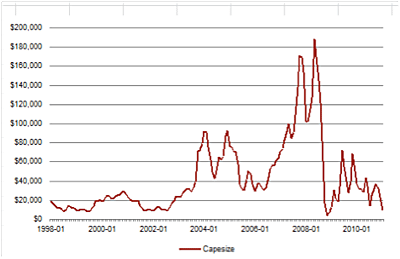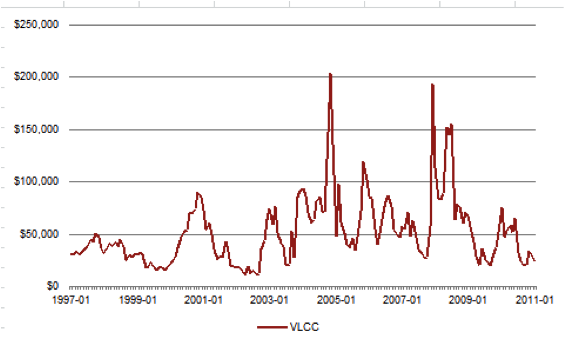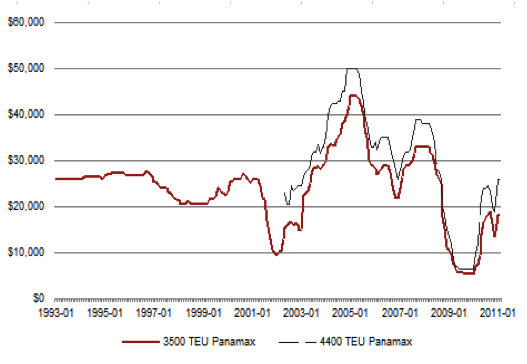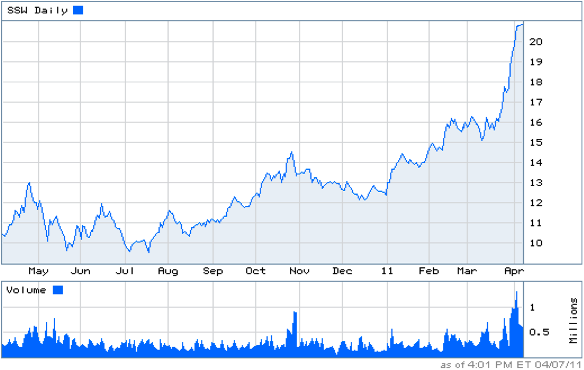SHIPPING NEWS
May 2011, Financial Advisor
An incidental story appeared in the Financial Times in mid-January that appeared to make little sense. The arcane sounding Baltic Exchange Dry Index–a.k.a. spot day rates which shippers charge–had collapsed to levels not seen since the height of the financial crisis. Since late October, day rates for the largest drybulk vessels had fallen from $46,284 to $8,894 as of early April.
These rates were less than operating costs, which, according to industry observers, run around $15,000 a day for these so-called capesize ships. More head scratching is prompted by the fact that shipping is generally considered a proxy for global growth. One would think these rates should not be plummeting if the world is supposedly in the midst of economic recovery.
This has translated into poor equity results. While the S&P 500 was up 15.7% over the past year through early April, the Capital Link Drybulk Equity Index [shipping.capitallink.com], which is comprised of 17 US-based drybulk companies, was off by 10.3%.
Whether this suggests an investing opportunity or a bear trap depends on the answers to several basic questions.
Has shipping supply and demand fallen out of whack, compromising pricing power, profitability, and equities?
Is the global recovery weaker than many economists suggest it is?
Or are shipping industry finances more complex than spot rates convey, involving forces more dynamic than one would think would be associated with such capital-intensive operations?
Getting a handle on the shipping business is an essential first step to deciphering the sector. Some basics. Shares tend to be small-cap stocks and often pay attractive dividends that range from 3 to 8 percent. Though perceived as long-term macro plays driven by economic growth and global trade, ocean shipping rates and equity prices are volatile.
The sector is diversified, with rates and profitability varying according to vessel type, which are dominated by dry bulk, tankers, and container ships. They collectively represent 84% of tonnage capacity, according to Douglas Mavrinac, head of Maritime Group of the global investment bank Jefferies.
Shipping firms typically manage just one type of vessel. Each carry distinct products, whose markets behave very differently from one another. For example, while demand for finished Chinese goods could mean a boon for container shippers, a slowdown in crude oil demand could cut into tanker rates.
But there is another factor that’s unique to the sector that affects pricing and profitability. Unusual spot rate volatility [see graphs below] appears to be based on geography–where last minute marginal demand is coming from and where empty ships are.
It’s as if, according to Mavrinac, day rates are a matter of the tail wagging the dog. Interestingly, the recent move to slow down ship speeds to improve fuel efficiency has in essence decreased mile-tonnage availability [i.e., supply], which improves pricing power while enabling companies to better choreograph ship movement.
But relatively low rates indicate imbalances still prevail across most of the sector, which will likely be exacerbated over the near term by the disaster that has befallen Japan. Mavrinac estimates that before the earthquake, nearly 9% of crude tankers were destined for Japan as were 16% of all dry bulk, and the country’s exports accounted for 10% of containershipping.
Michael Webber, senior shipping analyst at Wells Fargo, estimates that immediately following the disaster, one-quarter of Japan’s oil refining capacity was knocked offline and five large steel mills, which produced more than 15 million tons of steel per year, went dark. “Until the radiation threat is resolved and power restored to normal levels,” posits Webber, “these key industries will remain operating well-below capacity, which will significantly reduce import volumes.”
Dry Bulk
As it names suggests, dry transport involves raw commodities such as iron ore, coal, and grains. While there has been steady demand from key growth areas including China and India for these commodities, the collapse in day rates were in part attributed to massive shipping disruption caused by widespread flooding across the commodity-rich zones of Queensland, Australia. Forty percent of the coking coal for steelmaking worldwide comes this Australian state.
There was also weather-related disruption in Canada’s St. Lawrence Seaway, through which a major source of iron ore flows. And the short-term hit taken by Japanese imports and exports will hurt.
But perhaps the most systemic hit is coming from the 25 percent increase in the number of capesize ships that are expected to come online this year. This will push the size of the fleet to more than 1,240 boats, according to London-based shipbrokers Simpson, Spence & Young. This would suggest that dry bulk shippers may not be able to regain pricing power any time soon, at least not without a significant surge in demand for certain raw commodities.
With rates gapping below costs, dry bulk shipping is exposed to greater counterparty risks than the other shipping industries, explains Wells Fargo’s Webber. In the current environment, shipping contracts may be broken or significantly renegotiated. Webber believes the outlook for dry bulk is at best flat over the intermediate term, with only pockets of opportunity.
Jefferies’ Mavrinac thinks the massive rebuilding of Japan and the significant increase in demand for coal to make up for the loss in nuclear power will likely be catalysts for dry bulk shipping.
FBR Capital markets shipping analyst Doug Garber believes that with investors already anticipating asset price deflation, dry rates may see a catalyst from receding floodwaters in Queensland and a slowing in the actual number of vessels that will be ordered. “The overhang from a large order book should diminish in a year as deliveries outpace orders,” says Garber.
Garber likes Diana Shipping [DSX], due to its strong balance sheet, strong contract coverage, disciplined investments approach, and potential to grow in a weak asset price environment. He also likes Star Bulk Carriers [SBLK] for its attractive valuation at 0.8 times NAV and 8.5 percent dividend. However, shares of both companies have barely budged since early 2009 after they lost two-thirds of their value during the recession.
Dry Bulk Daily Spot Rates
Tankers
While tanker rates having fluctuated over the past several years with shifting demand for crude and refined petroleum products, Jefferies’ Douglas Mavrinac expects crude inventories to continue to decline and OPEC production to increase production by the middle of the year. “Global oil demand continues to surprise to the upside,” says Mavrinac, and “this trend should provide a significant boost to tanker demand.” He sees limited downside risks with charter rates already very low. And shares are trading at discounted valuations despite evidence of significant potential positive near-term catalysts.
Tanker Daily Spot Rates
The industry’s order book has fallen sharply from 50% of the fleet size as of the fourth quarter 2008 to a first quarter 2011 rate of 26 percent. Michael Webber expects this trend to continue to diminish. “Tanker rates and equity prices have been in a protracted down trend,” says Webber, and he thinks we’re near the trough. Believing the supply and demand dynamics could turn positive as soon as the third quarter, Webber believes the industry is poised for a multi-year rally.
He sees upside driven by expanding crude demand from China and developed economies as they continue to recover. He believes shares of Frontline [FRO] and Overseas Shipholding Group [OSG] are well positioned to capture this improvement, with substantial portion of total returns coming from attractive yields: 7.68% from FRO and 5.57% from OSG. These shares are also on Mavrinac recommended list. However, after having significantly sold off during the recession, these shares have realized only modest gains over the past two years.
Containerships
Most analysts believe containerships is the healthiest segment of the shipping sector.
FBR’s Doug Garber observed that the industry was hit by a slow down in demand due to the recession. But demand has since recovered, absorbing excess capacity and reactivating laid-up vessels. This is setting the stage for the industry’s next growth phase.
Container Daily Spot Rates
With worldwide containership trade at record levels, Garber expects the market to continue to tighten this year and next. He in fact suspects the market could find itself undersupplied as of late 2012 and 2013. Accordingly, he anticipates a 30% year-over-year increase in day rates for feeder and intermediate-size container vessels in 2011.
Michael Webber sees the bull market in container shipping that started in 2010 continuing into 2011 driven by revitalized developed market demand, which fell 10% in 2009 but rose 9 percent last year.
Container shippers are also demonstrating better supply control. “We’ve seen order books drop by more than half from their peak of 60% in 2008 to 27% in early 2011,” observes Webber. And capacity has been further reduced by slowing ship speeds.
Among the most compelling shares in the container industry–as well as in the entire sector–are those of Hong Kong-based Seaspan [SSW]. The firm is a leading independent ship owner and lessor, operating a container fleet of 57 vessels with another 12 scheduled for delivery within the next year. It is sheltered from the volatility of spot rates through leases to operators that average ten years.
But since their inception in mid-2005, shares of Seaspan have seen rough seas. They soared nearly 70 percent over their first two years of trading, peaking at $37. They then collapsed to the mid-single digits at the bottom of the financial crisis, but have since quintupled in value.
According to Lazard Capital Market’s maritime analyst Urs Dür, availability of the larger containership market, in which Seaspan serves, is limited and fully contracted, with rates and asset values likely to continue to improve.
Wells Fargo Webber believes that revenue and profit are poised to grow by 25-30% over each of the next two years. Seaspan, he says, “will have the capacity to materially increase its dividend [which it recently boosted from $0.50 to $0.75], fund additional growth and pay down debt.” However, long-term debt of $2.6 billion, that hasn’t started to amortize due to favorable borrowing terms, and a LT Debt/Total Capital ratio of nearly 64% are material concerns to Webber. But these figures aren’t extraordinary for this highly capital-intensive sector.
The firm recently sold $250 million in preferred shares aimed at buying ships and paying down debt. These shares [SSWprC] are a compelling income play. The 9.5 percent coupon makes the issue seem distressed. But this yield is more likely attributable to several benign factors. One, average long-term borrowing rates for shippers typically range between 8 to 10 percent for the highest quality firms, according to Jefferies’ Mavrinac. Two, Seaspan didn’t pay the debt rating agencies for a rating, and with the issue being on the small size, this has kept many institutional investors away. And three, shipping is an under followed sector as are preferred shares.
Given the favorable outlook for the container industry, Seaspan’s finances and management that Wells Fargo Webber regards as solid, a dividend that’s taxed at only 15 percent for individual investors, and of which 70 percent is deductable for qualified corporate investors, this preferred appears to be an unusual opportunity.
One-year Performance of Seaspan Common Shares
Through April 6, 2011
The preferred also enjoys a uniquely defensive feature in being cumulative. This means that any dividends that are missed must be entirely made up before the company can pay a common share dividend. With dividends a key for attracting investors, the preferreds’ cumulative character makes dividend payment highly likely under virtually all scenarios save bankruptcy.
Intermediate-term risks to Seaspan, as well as to all other shippers, include a slowdown in global growth, especially in the major emerging markets–including China, India, and Brazil–that have been driving trade in commodities and finished goods. Nearer term, dry bulk imports to and exports of finished goods from Japan will significantly slow in the aftermath of the disaster.
Generally, Omar Nokta, head of research at the boutique research firm Dahlman Rose, also sees risks associated with the sector being cyclical, seasonal and susceptible to external shocks such as one we’ve just witnessed in the Far East. This can lead to volatility in charter rates and asset values. And Nokta reminds investors that the “changes in the regulatory and environmental regulations may limit the useful life of vessels and may require additional upgrades and capital expenditures that could affect cash flows and income.”
Clearly, shipping is a challenging investment. But it is an essential sector in an increasingly globalized economy that can diversify a portfolio geared to growth while offering attractive dividend income. As of early April, many leading shippers look relatively cheap, and could become even more so if the tragedy in Japan drives prices down even further.



 GIR's Investing in the New Europe
GIR's Investing in the New Europe







